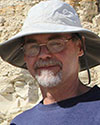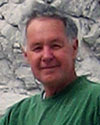2013 Kirk Bryan AwardPresented to Kyle House, Philip Pearthree, and Michael Perkins |
|||
[ view response ] |
[ view response ] |
[ view response ] |
for their 2008 GSA Special Paper “Late Cenozoic Drainage History of the Southwestern Great Basin and Lower Colorado River Region: Geologic and Biotic Perspectives”
|
Citation by Gordon E. Grant and Jim O’Connor
Years ago, while lecturing his Geomorphology class, Reds Wolman sternly admonished us with the injunction that he had received from his advisor, Kirk Bryan: “I never want to catch any of you running away from a flood!” Both Bryan and Wolman would be proud of this year’s recipients of the Kirk Bryan Award: Kyle House, Philip Pearthree, and Michael Perkins for their 2008 GSA Special Paper: Late Cenozoic Drainage History of the Southwestern Great Basin and Lower Colorado River Region: Geologic and Biotic Perspectives. For the authors of this paper have not only raced towards a flood, they’ve discovered several new ones, and used this and other evidence to paint an insightful, dramatic, and compelling story about the evolution of the lower Colorado River. Their work is a testimony to how careful field mapping and stratigraphy can lead to profound insights into Earth’s history. They leverage new observations against long-standing but incompatible models of how the Colorado River established a through-going passage to the Gulf of California. Observations are weighed against models until a compelling scenario of downstream-directed integration by basin filling and catastrophic spilling remains the only hypothesis standing. Though focused on a specific place, this report has great significance both for understanding landscapes of the Colorado Plateau and southern Basin and Range Provinces, and interpreting general mechanisms of drainage integration. . Cogently written and beautifully illustrated, the paper is a model for how to use the particular to illuminate broad insights into surficial processes.
We’ve known for some time that the Colorado River traversed the Colorado Plateau by the mid Tertiary, but how it finally connected to the sea through the lower Colorado River valley in the Pliocene was unknown. Two main hypotheses have been proposed: (1) subsidence, marine incursion, and headward tributary erosion captured the Colorado River; and (2) downstream directed integration by lake spillover ultimately led the Colorado River to the Gulf of California. House and colleagues show that the distribution, sedimentology and geochoronology of deposits in Cottonwood and Mohave Valleys reveal a history of late Miocene closed basins accumulating locally derived sediments, only to be cataclysmically inundated by water as divides were breached, and far-travelled sediments of Colorado River provenance arrived. They reinterpret evidence for marine incursion as indicating a series of freshwater lakes, fed by the Colorado River, stair-stepping through tectonic basins to the Gulf. This conclusion has wide relevance, not only to understanding late Cenozoic landforms of the southwestern U.S., including the Grand Canyon, but also interpreting processes of drainage integration worldwide.
The paper also illustrates how a field study, undertaken with open eyes and broad peripheral vision, can, with a bit of luck, advance understanding of the Earth’s history. Multiple working hypotheses are tested against field evidence. The landscape’s history is revealed as a sequence of contingent events. Process-based mechanisms bring order to the field evidence. Floods are embraced. There is a palpable sense of joy of discovery throughout. It’s clearly a distinguished geomorphic contribution worthy of the Kirk Bryan Award.
 2013 Kirk Bryan Award — Response by Kyle House and Phil Pearthree
2013 Kirk Bryan Award — Response by Kyle House and Phil Pearthree
Thank you, Gordon Grant, for your kind words, for nominating our paper, and for your enthusiastic interest in the development of these ideas over the last several years. It is an inspiration to know that our efforts have piqued the curious mind and garnered the professional respect of an esteemed colleague.
It is with great surprise, and humility that I accept this award for my coauthors and myself. To be honored in this way and by this organization is truly a peak professional moment for each of us.
There are many colleagues we would each like to thank, but first, the essentials: our parents, spouses, kids, and other major players in our lives who have borne shades of financial and familial burden created by our intense interest in studying and roaming the American desert for all these years--and for accepting the fact that such roaming will continue for as long as we can manage.
Phil and I share a common academic heritage in geoscience education at the University of Arizona and we have worked together for nearly 25 years. It is fitting that we should share an award like this, though surprising to us both that we would ever qualify for one. For this honor, we owe tremendous gratitude to our common mentors: Vic Baker and Bill Bull. Together, they created a huge and uniquely complementary influence on our approach to geology. In short, Vic Baker schooled us to think big; to look for anomalies in the landscape and in the conventional wisdom; and to not shy from seemingly outrageous or genuinely iconoclastic ideas; and Bill also taught us to think big but also to appreciate the simple elegance of fluvial geomorphic systems; to spend as much time in the field as possible; and to create geologic maps of our study areas to see if the story really holds up.
Phil and I also want to thank our colleagues: John Bell, Jim Faulds, and Alan Ramelli of the Nevada Bureau of Mines and Geology; Jon Spencer of the Arizona Geological Survey; Jon Patchett, Bill Dickinson, and Andy Cohen of the University of Arizona; Becky Dorsey of the University of Oregon; Karl Karlstrom and Laura Crossey of the University of New Mexico; and Sue Beard, Keith Howard, Dave Miller, Jim O’Connor, and Marith Reheis of the U.S. Geological Survey for their insights, skepticism, and enthusiasm in the early development of our ideas.
This paper is the outcome of an ongoing geologic mapping project of the lower Colorado River corridor. As professional geologic mappers we are dedicated to the idea that regional geologic problems can be characterized by studying the perfect section, but that such site-specific observations can only be understood in their appropriate geologic and geomorphic contexts through mapping. Geologic mapping provides essential spatial context to understanding regional geologic history. Geochronology is essential to all mapping projects, and the addition of Mike Perkins to our small team ensured that we could place the geologic and geomorphic relationships that we found in a viable chronological context. The tephra ages determined through Mike's careful efforts provided vital age constraints on deposits that chronicle the initial development and early evolution of the lower Colorado River, greatly narrowing the window of time in which a series of dry desert valleys became hosts to huge lakes and then to a major through-flowing river.
The physical evidence that we found in our mapping combined with age-controls afforded by key, tephra-bearing deposits in the greater map area is the award-winning combination here. Thus, this award recognizes the value of geologic mapping and serendipitous discoveries only begotten by related fieldwork…lots of fieldwork.
Our paper presents an interpretation of the history of the river that involves a simple model of river integration along a descending chain of spilling lakes; it challenges a long-standing and decidedly more complex model involving a sequence of subsidence, marine incursion, headward erosion, drainage capture, uplift, and river progradation and aggradation. The findings and ideas in our paper came on the heels of a novel geochemical argument for spilling lakes published by Jon Spencer and Jon Patchett in 1997. Their work gained some traction in the geoscience community, but was contentious nonetheless. There is stark proof of such contention. Notably, a 2001 workshop volume on ‘Colorado River Origin and Evolution’ specifically relegated two papers using geomorphic arguments to build on the spilling-lake theme to a section entitled: 'Selected Theories and Speculation'. Evidently they were considered amongst the few papers in the volume that involved speculation. Of course, what they involved were new ideas that challenged conventional thinking. Ironically, what very few workshop participants and contributors knew at that time was that we had just discovered the key physical evidence attesting to the veracity of the spilling-lake model in a ‘golden section’ behind a casino in Laughlin, Nevada.
Of course, as is often the case, the spilling-lake idea isn't new. The eminent geologist Eliot Blackwelder first proposed a spilling-lake origin for the same reach of the Colorado River on geomorphic grounds in the early 1930s. Nonetheless, the complex marine incursion-headward erosion-stream capture-uplift-river progradation model was subsequently developed by others and came to dominate conventional wisdom for decades. In contrast, the spilling-lake model has received considerably more scrutiny in considerably less time, all in the face of more robust evidence in its favor.
That final point about greater and earlier scrutiny on the 'new model' is actually a particularly satisfying one, because it reflects positively on how science should work. We are extremely proud to have been recognized for doing good science that contributes towards greater understanding of the evolution of one of the Earth's great rivers.
 2013 Kirk Bryan Award — Response by Mike Perkins
2013 Kirk Bryan Award — Response by Mike Perkins
When I received a letter last May from George Davis, the recent president of the G.S.A., I was both surprised and honored to learn that I, along with colleagues Phil Pearthree and Kyle House, had received the Kirk Bryan Award. This award recognizes our investigation of the inception of the lower Colorado River.
My role in this investigation was the analysis and correlation of three key tephra in Pliocene units of the lower Colorado River area. Using electron microprobe analyses of the glass shard fraction of these tephra I was able to match them with tephra in the University of Utah’s Late Cenozoic tephra database. This database was assembled by myself and my colleagues Frank Brown, Barbara Nash, and Steve Williams at the University of Utah with assistance from Andrei Sarna-Wojcicki at the United States Geological Survey in Menlo Park.
My comparison of the analyses of the Colorado tephra with those in the Utah database clearly support correlations with the Wolverine Creek Tuff, the Olson Ranch Tuff (“lower Nomlaki Tuff”), and the Nomlaki Tuff. The first of these tephra is a Yellowstone Hotspot tephra with a source in the eastern Snake River Plains. The other two tephra have likely sources in the Lassen Peak, California area.
With the geochronological information in the Utah database I was able to assign ages to the three tephra as follows : 5.65 ± 0.05 Ma (40Ar/39Ar age) for the Wolverine Tuff; 4.1 ± 0.2 Ma (interpolation age estimate) for the “Lower Nomlaki Tuff”/Olsen Ranch Tuff; and 3.27 ± 0.07 Ma (interpolation age estimate) for the Nomlaki Tuff
In closing, I wish to thank the Kirk Bryan Award selection committee for honoring both myself and my colleagues with this award.



